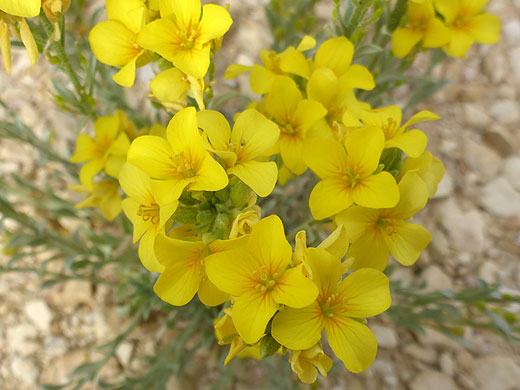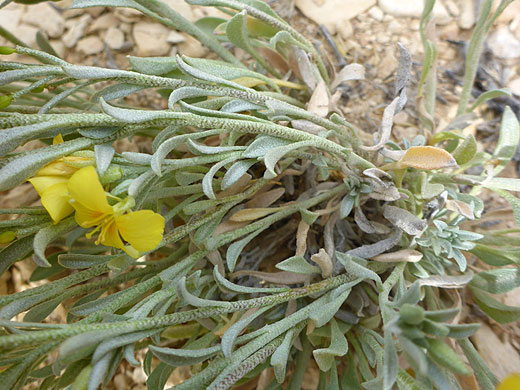
Four-petaled yellow flowers - physaria fendleri along the Dome Trail in Big Bend Ranch State Park, Texas
Common name:
Fendler's bladderpod
Family:
Scientific name:
Physaria fendleri
Synonym:
Lesquerella fendleri
Main flower color:
Range:
The Four Corners states, and west/central Texas
Height:
Usually up to 10 inches
Habitat:
Washes, rocky hillsides, limestone outcrops, desert scrubland; 400 to 6,500 feet
Leaves:
Linear to narrowly elliptic or oblanceolate, less then 2 inches long
Season:
March to May
Leaves and stems of physaria fendleri appear greyish-blue in color due to a dense covering of small, branched (stellate) hairs. Plants produce many stems, growing close together, with alternate, upwards-pointing leaves at closely-spaced intervals. Stems are usually unbranched, and erect. Stem leaves are narrowly oblanceolate, about one inch long, and may be slightly curved up at the edges. Basal leaves are a little longer, and widest in the middle. Leaf margins are usually entire but may have a few teeth towards the tip.
The inflorescence is a dense, compact cluster at the tip of each stem. Flowers are formed of four green, oblong or elliptic sepals and four larger yellow, obovate petals, often tinted orange towards the base, which is narrow (clawed). Petals are crossed by veins, branching from the base. Fruits are nearly spherical, colored green, or reddish when mature.
The inflorescence is a dense, compact cluster at the tip of each stem. Flowers are formed of four green, oblong or elliptic sepals and four larger yellow, obovate petals, often tinted orange towards the base, which is narrow (clawed). Petals are crossed by veins, branching from the base. Fruits are nearly spherical, colored green, or reddish when mature.
All Contents © Copyright The American Southwest | Comments and Questions | Contribute | Site Map





